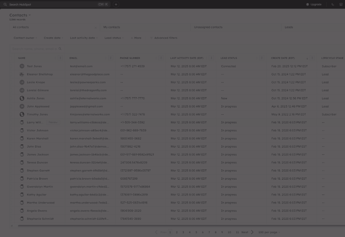When it comes to adopting a new platform like HubSpot, there are two words that often pop up: onboarding and implementation. And let’s be real—if you’ve ever scratched your head wondering, "Wait, aren’t those the same thing?" you’re not alone. While both onboarding and implementation are essential steps in the HubSpot journey, they serve completely different purposes.
HubSpot has become a critical tool for businesses looking to scale their marketing, sales, and customer service efforts. With its powerful CRM, marketing automation, and service tools, it can be a game-changer for any company, whether you're a small startup or an enterprise-level organization. However, just because HubSpot is powerful doesn’t mean it’s easy to master right off the bat.
That’s where we come in. As a certified HubSpot Solutions Partner, we help businesses navigate the complexities of HubSpot through both onboarding and implementation services. So, whether you’re just dipping your toes into HubSpot or diving headfirst, understanding the difference can save you time, headaches, and, yes, a few late-night Google searches. But before you jump into either process, let’s break it down.
What is HubSpot Onboarding?
HubSpot Onboarding is like getting a shiny new car and learning how to drive it. The car (HubSpot) has all the features you need, but onboarding teaches you how to use them without driving straight into a metaphorical ditch. In short, it’s all about making sure you and your team know how to operate HubSpot’s tools effectively.
Here’s the thing—HubSpot is a massive platform with tools for sales, marketing, customer service, and more. During onboarding, we focus on training users, providing educational resources, and helping users with initial tasks like setting up accounts, entering data, and understanding key features. It’s user-focused, ensuring that your team feels confident navigating HubSpot’s core features.
Our onboarding process isn’t just a one-size-fits-all tutorial. We tailor our training to fit your business needs. A typical onboarding might include:
- Setting up accounts: Helping users create profiles, define roles, and ensure permissions are properly configured.
- Entering data: Teaching you how to structure and upload contact data, deal records, and other critical business information.
- Understanding key features: Providing educational resources and tutorials on the essential features of HubSpot so your team knows what to do from day one.
What is HubSpot Implementation?
If onboarding is learning how to drive the car, HubSpot Implementation is more like customizing that car so it’s built specifically for your lifestyle. Maybe you want heated seats or need to integrate the latest GPS system. Implementation focuses on the behind-the-scenes setup that makes HubSpot align with your company’s existing systems and processes.
Implementation is system-focused. It’s all about integrating HubSpot with other software your business already uses, like Salesforce, Google Analytics, or even your email marketing platform [if it isn’t HubSpot ;)]. You might also need to migrate large amounts of data, set up advanced workflows, create email campaigns, or configure custom reports. It’s like fitting HubSpot to your company’s needs like a glove.
Our implementation services go beyond just turning on HubSpot and wishing you luck. We handle the technical heavy lifting:
- Data migration: Bringing over existing customer data, contacts, and deal records from your current CRM or database.
- Custom integrations: Syncing HubSpot with tools like Salesforce, Slack, Shopify, QuickBooks, Aircall, and more. If your business has unique needs, we can create custom APIs that connect HubSpot to your current systems.
- Creating email campaigns and setting up workflows: Automating complex workflows and designing email campaigns that fit your marketing strategies.
- Custom dashboards: Designing dashboards tailored to your team’s KPIs, so you can monitor performance and make data-driven decisions.
A great example is a client of ours in the healthcare industry. They needed to integrate HubSpot with multiple third-party tools, including a custom-built patient management system. Our implementation team configured HubSpot to not only sync with these systems but also automate follow-ups and reminders for patients. This significantly reduced manual work for their staff and increased efficiency by 40%.

Key Differences Between HubSpot Onboarding and Implementation
Okay, so here’s where we get into the nitty-gritty. Let’s compare the two processes side by side to clear up any lingering confusion.
HubSpot Onboarding |
HubSpot Implementation |
|
User-Centric: Focused on training your team to use the platform effectively. |
System-Centric: Focused on the technical setup, data migration, and integration with other tools. |
|
Initial Setup: Includes training users, providing educational resources, and helping users with tasks like setting up accounts, entering data, and understanding key features. |
Advanced Setup: Involves system configurations, data migration, integrations, custom reports, creating email campaigns, and setting up workflows. |
|
Quick Start: Ideal for getting your team up and running within weeks. |
Time-Intensive: Can take several weeks or months, depending on the complexity of your business needs. |
|
Training Focus: Ensures users know how to interact with HubSpot’s tools daily. |
Technical Focus: Ensures HubSpot is customized and works smoothly with your existing business systems. |
To sum it up, onboarding focuses on making sure your team can actually use HubSpot, while implementation is all about tailoring the system to meet your unique business needs. Whether you’re training your team or setting up advanced automations, each process plays a crucial role.
Let’s say your company just started using HubSpot. If you want to quickly get your team up to speed and generating results, onboarding is your best bet. But if you’re looking to fully integrate HubSpot into your existing tech stack and build out custom workflows, implementation is what you need. And in many cases, businesses require both to get the most out of HubSpot.
How to Decide Which Service You Need
Now that we’ve covered the basics, you might be wondering, “Which one do I need?” Good question! The answer depends on your business’s specific circumstances, including your size, tech stack, and internal capabilities.
When to Choose Onboarding
If your team is new to HubSpot, onboarding is essential—no matter your company size. Whether you’re a startup with a handful of employees or a large enterprise, onboarding will give you the confidence and know-how to start using HubSpot right out of the gate. You’ll get training on how to manage contacts, set up workflows, and use HubSpot’s tools effectively.
Even for larger companies, onboarding ensures that teams across departments—whether sales, marketing, or customer service—are all on the same page and ready to collaborate within HubSpot. Think of onboarding as the foundation that sets your entire team up for success.
When to Choose Implementation
If your company has complex systems, or needs HubSpot to work alongside existing platforms like Salesforce or Shopify, implementation is a no-brainer. Large enterprises with multiple systems, tons of data, and a need for custom integrations will absolutely benefit from a thorough HubSpot implementation.
But here’s the twist: smaller teams may also choose implementation because they often lack the time, staff, or skills to handle the technical configurations themselves. For example, a small business that doesn’t have an IT team might find the process of setting up integrations and automations overwhelming, and this is where we can step in.
Many businesses find that they need both services. Onboarding helps your team get comfortable with HubSpot, while implementation ensures that HubSpot is set up to work for your specific needs. We’ll help you figure out the best path forward, whether that’s one or both.
Why Choose Eternal Works as Your HubSpot Solutions Partner?
By now, you’ve probably gathered that onboarding and implementation are both critical in their own way. The good news is that we offer both, so you don’t have to choose between understanding the platform and making it work for your business.
As a HubSpot Solutions Partner, we bring years of experience working with companies of all sizes across various industries. Our team offers a tailored approach, whether you need basic training or advanced technical setup. Here’s what sets us apart:
- Personalized onboarding: We’ll create a customized onboarding plan that fits your business’s needs.
- Seamless implementation: From integrations to custom workflows, we make sure HubSpot is tailored to your unique requirements.
- Ongoing support: Even after onboarding and implementation, we’re here to provide support and additional training whenever you need it.
We don’t just drop you off once the onboarding or implementation is done—we make sure you’re fully equipped to keep moving forward. One of our clients, a mid-sized ecommerce company, saw a 50% increase in sales leads within the first three months of our services because they had a fully customized HubSpot setup and knew exactly how to use it.
But don’t just take our word for it—our clients rave about how our hands-on approach has transformed their HubSpot experience. We’re all about making the complex simple and the overwhelming manageable.
Conclusion
HubSpot Onboarding and Implementation might seem like two sides of the same coin, but each plays a vital role in helping businesses get the most out of the platform. Onboarding helps you learn the ropes, while implementation sets you up for long-term success by customizing the platform to fit your unique needs.
So, whether you’re new to HubSpot or just need a better way to integrate it into your business, we’ve got your back. Ready to get started? Reach out to us today for a consultation and let’s figure out the best HubSpot journey for you!


